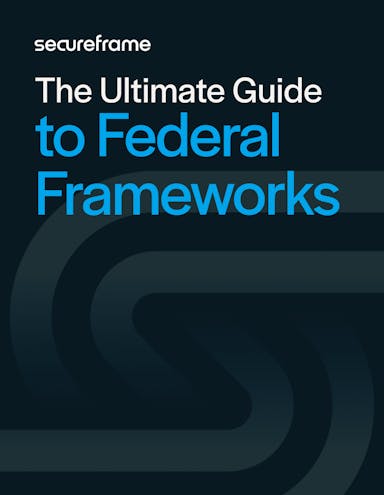If you’ve ever felt overwhelmed trying to figure out how federal compliance frameworks, laws, and standards all fit together, you’re not alone. FISMA, NIST 800-53, NIST 800-171, NIST RMF, and FedRAMP can all seem like a tangled web of requirements and guidance.
But here’s the good news: once you understand the roles each of these standards plays, the puzzle pieces start coming together. Let’s break it down.
How NIST standards guide FISMA compliance
The Federal Information Security Management Act (FISMA) is a 2002 law that requires federal agencies and their service providers to protect their information systems.
But FISMA doesn’t get into the nitty-gritty of how to achieve that protection — that’s where NIST comes in. The National Institute of Standards and Technology (NIST) publishes detailed guidance documents that shows exactly how organizations can meet FISMA’s requirements.
Think of it this way: FISMA defines what needs to be done, and NIST guidelines explain how to do it.
For example, FISMA requires agencies to manage cybersecurity risks. NIST’s Risk Management Framework (RMF) lays out the steps for managing those risks. Similarly, FISMA mandates organizations implement security controls, and NIST SP 800-53 provides the catalog of controls to choose from.

The NIST Risk Management Framework: Risk assessment guidance
The NIST RMF is like a roadmap for handling cybersecurity risks. It’s a step-by-step process designed to help federal agencies and contractors evaluate, implement, and monitor their security measures. RMF is essential for achieving FISMA compliance because it guides you through:
- Categorizing your system based on the impact of a potential security breach.
- Selecting appropriate security controls from NIST 800-53.
- Implementing and assessing those controls.
- Continuously monitoring the system to ensure it stays secure over time.
In short, RMF is how you take the general requirements of FISMA and turn them into actionable security practices.
NIST 800-53: Required security controls
If NIST RMF is the roadmap, NIST 800-53 is the toolbox. It provides a comprehensive catalog of 1,000+ security controls that federal agencies and their contractors can use to protect their systems and meet FISMA compliance requirements. These controls are grouped into families like access control, incident response, and risk assessment, and they are tailored to the system’s impact level (low, moderate, or high).
To comply with FISMA, organizations don’t need to implement every control in NIST 800-53. Instead, each impact level has an associated baseline of controls. Organizations use FIPS 199 and NIST Special Publication 800-60 to determine the appropriate impact level, then select and tailor security controls based on their system’s specific needs and risks. This flexibility makes NIST 800-53 adaptable to a wide range of federal systems.
NIST 800-171: Safeguarding CUI in non-federal systems
While NIST 800-53 is primarily for federal systems, NIST 800-171 is designed for systems that handle Controlled Unclassified Information (CUI). These are federal government systems, contractors, and vendors who process sensitive data that relate to the Department of Defense (DoD).
NIST 800-171 is a streamlined version of 800-53, focusing specifically on the controls necessary to protect CUI. If you’re a contractor working with federal agencies, you might not need to comply with the full scope of NIST 800-53, but you’ll likely need to implement the requirements in NIST 800-171.
Recommended reading

What You Need to Know About Controlled Unclassified Information (CUI): Categories, Controls, and Compliance
Read MoreFedRAMP: Cybersecurity standards for federal cloud service providers
The Federal Risk and Authorization Management Program (FedRAMP) is a specialized compliance framework for cloud service providers working with federal agencies. Like FISMA, it relies on NIST guidance, specifically the controls outlined in NIST 800-53. But FedRAMP tailors these controls for cloud environments, providing a standardized approach to securing federal cloud services.
If you’re a CSP aiming to work with federal agencies, FedRAMP certification ensures you meet FISMA’s requirements while addressing the unique challenges of cloud security. For cloud service providers, FedRAMP can act as a golden rubber stamp to work with any federal agencies.
Proving federal compliance through security assessments
Many federal frameworks require formal security assessments to demonstrate compliance with FISMA and NIST standards. This process demonstrates to government agencies that your system meets the necessary requirements and is capable of protecting sensitive information from data breaches and other security threats.
The security assessment process typically involves:
- Pre-assessment: Organizations begin by performing an internal review of their systems. This includes identifying the system’s impact level, selecting appropriate controls from NIST 800-53, and implementing them.
- Preparing documentation: Comprehensive documentation is essential. Key documents like the System Security Plan (SSP), Risk Assessment Report (RAR), and Continuous Monitoring Plan provide the evidence federal agencies need to evaluate your system’s security posture.
- Third-party security assessment: For moderate- and high-impact systems, a third-party assessment organization (3PAO) or independent assessor must evaluate the implementation and effectiveness of your security controls. Low-impact systems may rely on self-assessments, but these must still align with federal expectations.
- Authority to Operate (ATO): After the assessment, the federal agency’s authorizing official reviews the findings and determines if the system meets compliance requirements. If approved, the system is granted an ATO, allowing it to legally operate.
- Continuous monitoring: Compliance doesn’t end with an ATO. Organizations must continuously monitor their systems for vulnerabilities and risks, providing regular updates to federal agencies and completing periodic reassessments to maintain compliance.
How FISMA and NIST standards fit together
FISMA compliance might seem complex, but understanding its relationship to NIST standards makes it far more approachable.
FISMA defines the why protecting federal systems and data. NIST standards define the how: the exact steps and tools you need to achieve that protection. By following these standards, organizations can navigate FISMA’s requirements confidently and effectively.

The Ultimate Guide to Federal Frameworks
To address an increasingly complex and dangerous threat landscape, the US government has created several information security standards and frameworks for reducing risk and improving data security. Get an overview of the most common federal frameworks, who they apply to, and what their requirements are.
FAQs
What is the difference between NIST and FISMA?
FISMA is a federal law that mandates the protection of federal information systems, while NIST provides the standards, guidelines, and frameworks (like NIST 800-53 and RMF) that explain how to meet FISMA's requirements.
What is the difference between NIST 800-171 and FISMA?
FISMA applies to federal information systems and their service providers, requiring implementation of NIST 800-53 controls. NIST 800-171 is a subset of these controls designed for non-federal systems that handle Controlled Unclassified Information (CUI), like contractors working with federal agencies.
Is NIST a regulation or a standard?
NIST is not a regulation; it is a standards body that develops guidelines and frameworks, like NIST 800-53 and NIST 800-171, to help organizations comply with federal regulatory requirements such as FISMA.
What is the difference between FISMA ATO and FedRAMP ATO?
A FISMA ATO is specific to federal government information systems and is based on compliance with NIST 800-53 controls. A FedRAMP ATO applies to cloud service providers and involves a standardized assessment process tailored for cloud environments, also based on NIST 800-53 controls.
Is FedRAMP the same as NIST?
No, FedRAMP is a federal program that is based off of and uses NIST 800-53 controls to create a standardized approach to cloud security for federal agencies. It is built on NIST guidelines but focuses specifically on protecting cloud environments and cyber threats and unauthorized access.